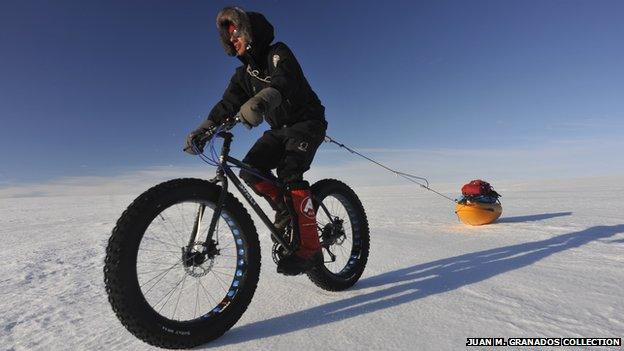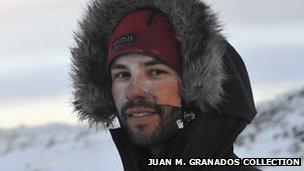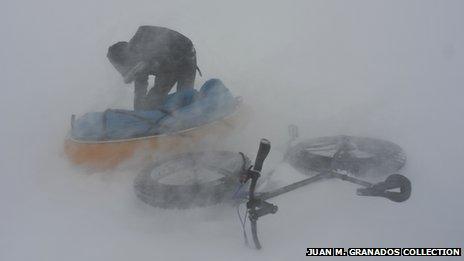An Antarctic bike ride to the South Pole
- Published

Menendez Granados will have to cover 1,200 km to reach the South Pole
Since Roald Amundsen's Norwegian expedition first conquered the South Pole in 1911 plenty of others have followed in his footsteps - but not necessarily by foot.
The journey has been completed with dog sleds, snowmobiles and four-wheel-drives. But no one had ever completed it on a pushbike. That is the challenge Juan Menendez Granados has set for himself. And he plans to do it solo.
The Spanish adventurer will have to cross 1,200km (750 miles) of snow and ice, and ascend a total of 3,000 metres, from the Antarctic coast to the South Pole.
He plans to set out around 1 December, or a few days before. During the 36 to 38 days the ride should last, he will be constantly exposed to extreme cold, with temperature seldom rising above -20°C.
"I have been preparing for this challenge for two and a half years," he tells BBC Mundo.
That training has included an expedition in its own right - a 27-day cycle-ride through Greenland in August-September this year.

The adventurer believes loneliness will be one of his greatest challenges
Long days
Although he might face less snowfall than he did in Greenland, Antarctica will be colder, and he will have the polar wind pounding him head on.
"[I need to avoid] getting my hands too cold to pitch the tent," he says.
That would be the tent where he will try to sleep a minimum of eight hours a day, after pedalling for eight to ten hours, hauling an 85kg load with all his supplies. That will consume much more than the 5,000 calories he expects to eat every day.
Being alone will bring its own complications. Loneliness will have an emotional impact. But it also means he will have no assistance on hand if he needs to be rescued.
In good weather conditions a rescue party would take five hours to reach him, according to Stephen Jones, member of the Royal Geographical Society and manager of Antarctic Logistics and Expeditions, which will support Menendez Granados.
"Worst case scenario," says Jones, "he might have to wait a few days for good weather".

In bad weather a rescue operation could take days to reach him
The bike
Jones agrees it is a very difficult enterprise. "He's got a greater risk of mechanical failure [than someone skiing or walking]."
But the latest evolution in bicycle design has been key in allowing adventurers to try their luck in Antarctica - Menendez Granados's bike has 12cm (4.7 in) wheels and modified forks. He has decided against using tyres with nails but says the broader tyres should provide the grip he needs.
"Several people have tried it over a few years, and none of them got anywhere at all, until last year," says Jones.
In January 2012, BBC TV presenter Helen Skelton reached the South Pole. Although she covered a much shorter distance - 800 km - and most of it was done on skis, she did cycle for 165km.
And in December 2012 the American Eric Larsen tried his hand on a similar bike to Menendez Granados's (Skelton's had a different design).
Larsen proved that "the technology isn't perfect, but is good enough," according to Jones.
Nevertheless, Larsen abandoned his attempt after covering 280km.
"I had to make the difficult decision to turn around as surface snow conditions prevented me from covering enough miles before [my] food and supplies ran out," he wrote in his blog, external.
A race?
Menendez Granados will try to make it all the way to the end.
He will not be the only one. The American Daniel Burton will also try to reach the South Pole on a solo trip on two wheels, and is leaving around the same time.
And by the end of 2014 the Australian Kate Leeming will attempt the challenge.
It looks like a race then. But the Spaniard disagrees: "Antarctica is not a good place for races."

At the beginning of the journey the load will be 85kg
Changing equipment
Although it is considered a cycling expedition, there will be times when he will have to dismount, put the bike on the sled and pull.
"There are bits where you have to walk," says Jones, who adds that Menendez Granados will be carryings skis to use when pedalling becomes impossible, especially on soft snow where walking would also be hard.
But if he skis in certain stretches, would he then be able to claim he was the first person to reach the South Pole by bike?
"The fact is that I will not be able to change the conditions I will encounter, whatever they are," says the adventurer.
"I will try to do as much as possible on the bicycle and in normal conditions it should be considered a bike expedition."
Jones believes that it could be claimed that he did it by bike if he spends some 30 days pedalling and the rest on skis.
Menendez Granados does not plan to ride back either. "Cycling back would involve carrying extra food [he plans to carry enough for 40 days] and leaving earlier, which would reduce the chances of success almost to zero," he explains.
Jones agrees that this strategy will help maximise his chances - though, he points out - a "good chance" in Antarctica is probably only "50-50" in real terms.
- Published27 October 2013
- Published6 October 2013
- Published22 January 2012